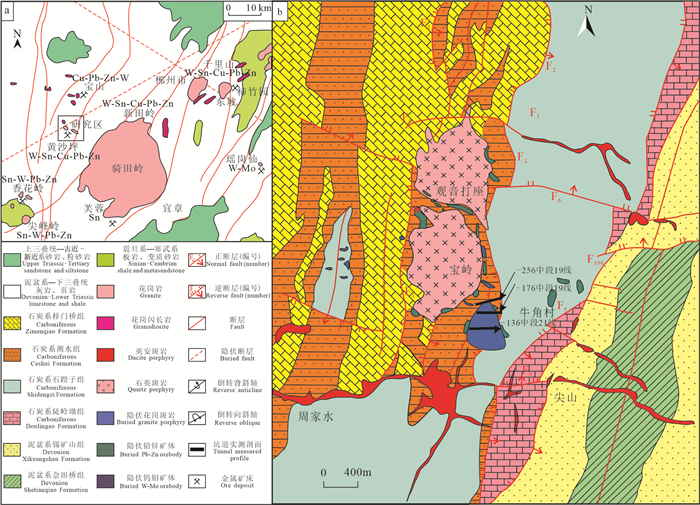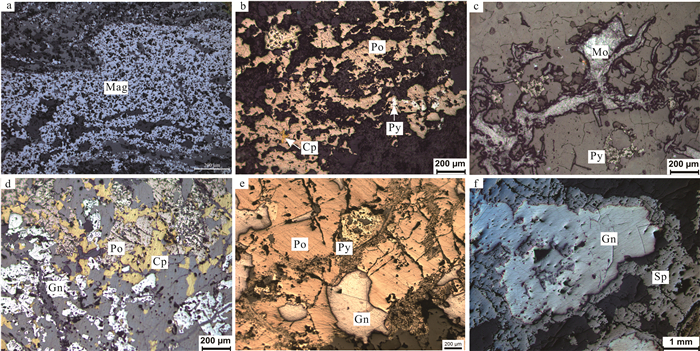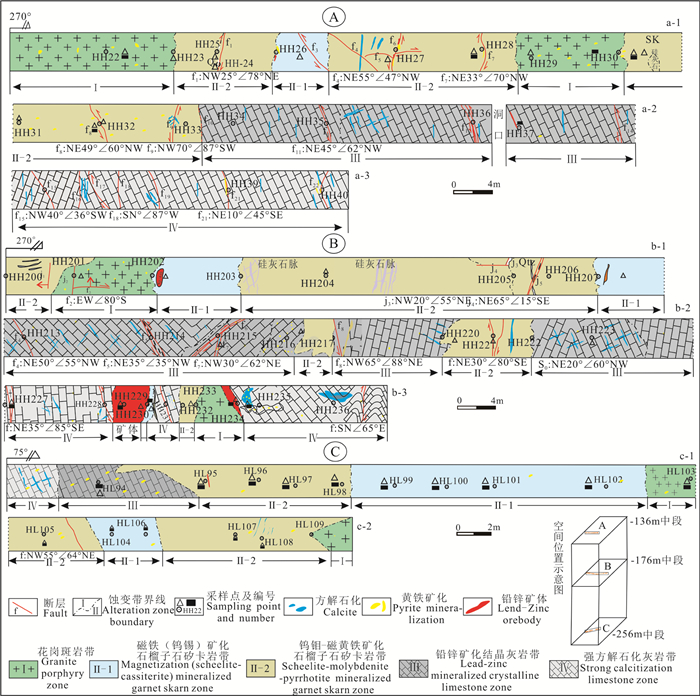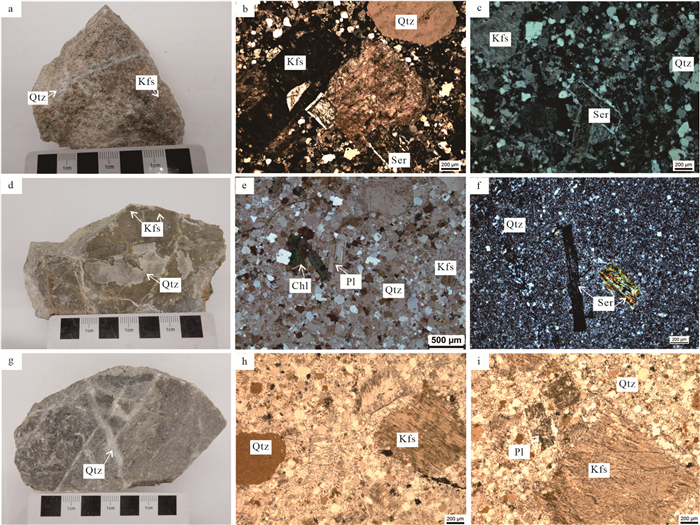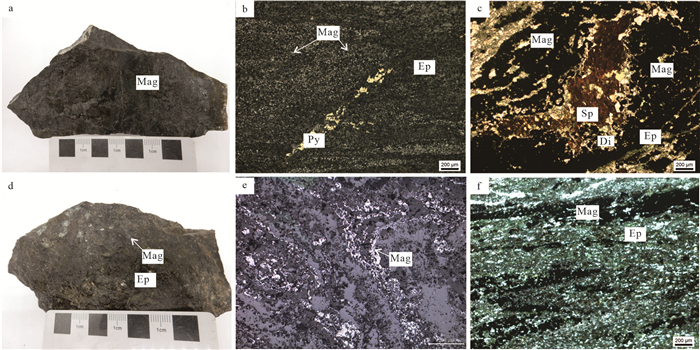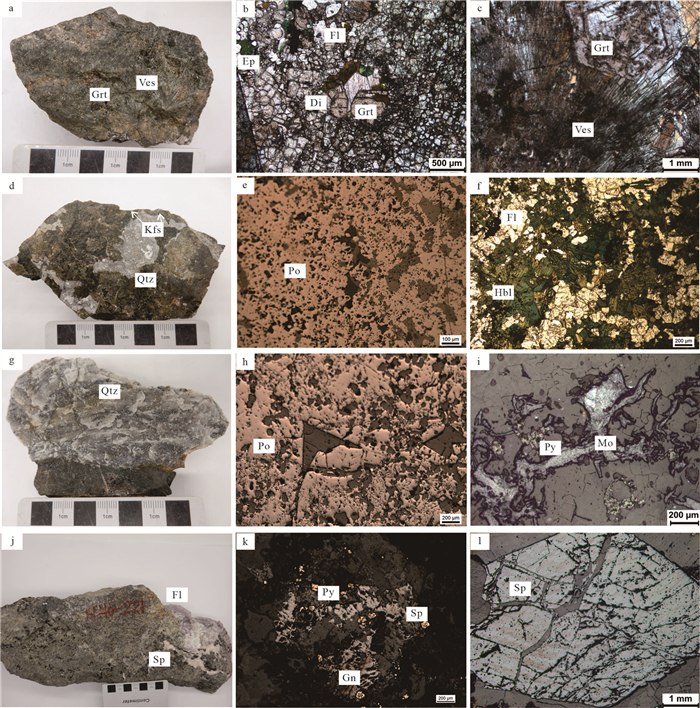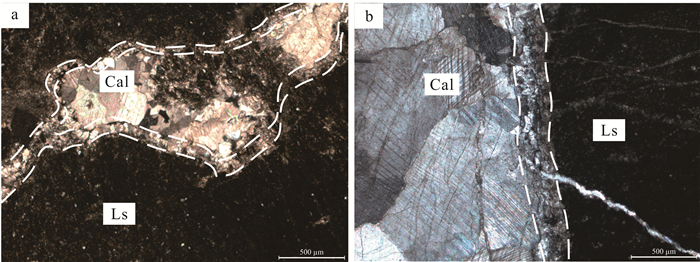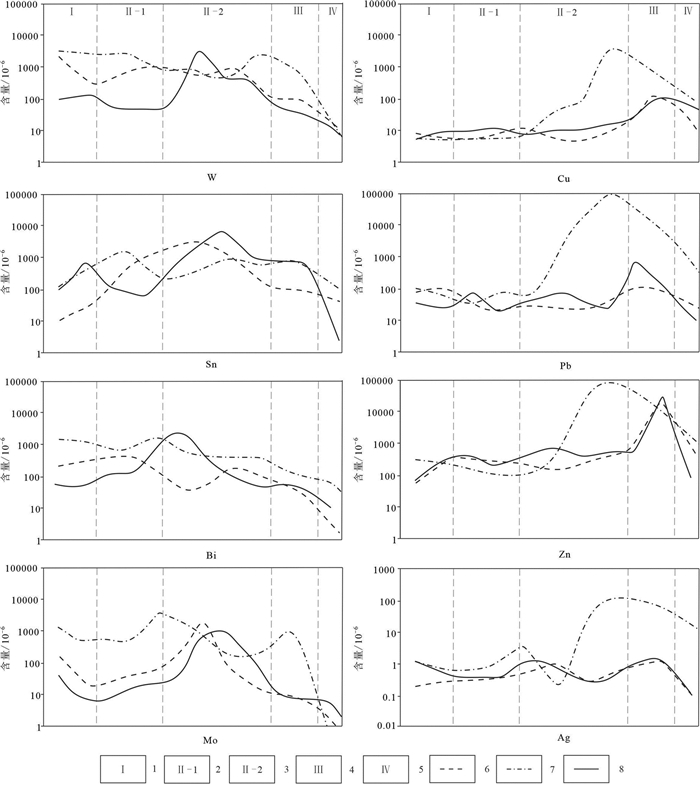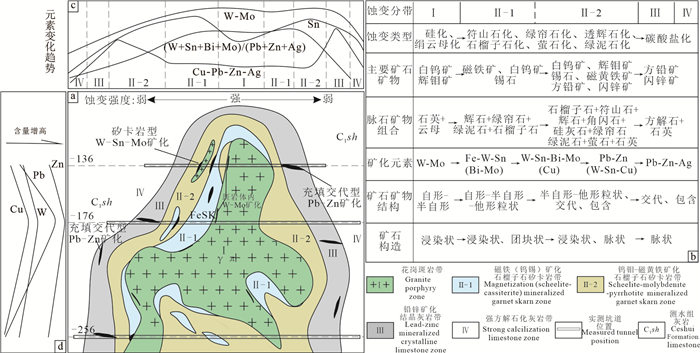The mineralization and alteration zoning model related to the concealed granite porphyry of the Huangshaping Cu-Sn polymetallic deposit, Southern Hunan Province
-
摘要:研究目的
黄沙坪铜锡多金属矿床是湘南地区岩浆热液成矿系统的典型矿床之一。为了深化研究该矿床成岩成矿机制、高效指导深部找矿勘查,需要揭示与隐伏花岗斑岩有关的多金属矿化-蚀变分带规律,构建深部矿化-蚀变空间分带模式。
研究方法应用热液矿床的大比例尺蚀变岩相定位找矿预测方法,开展矿区内-136 m、-176 m、-256 m中段典型穿脉剖面的矿化蚀变测量和矿物岩石地球化学研究,剖析了矿化-蚀变的强弱变化、矿物共生组合及其空间分带特征,探讨了成矿元素、元素组合及其元素比值变化规律。
研究结果构建了矿化-蚀变空间分带模式:从花岗斑岩体(内带)→接触带→围岩(外带),依次为钨钼(黄铁)矿化-硅化-绢云母化花岗斑岩带(Ⅰ)→磁铁(钨锡)矿化石榴石矽卡岩带(Ⅱ-1)→钨钼-磁黄铁矿化石榴石矽卡岩带(Ⅱ-2)→铅锌矿化结晶灰岩带(Ⅲ)→强方解石化灰岩带(Ⅳ)的分带规律,各带对应的主要矿物组合为:石英+(黄铁矿+绢云母)→磁铁矿+透辉石+硅灰石+绿帘石+绿泥石+(白钨矿+锡石+黄铁矿+石榴石)→白钨矿+辉钼矿+磁黄铁矿+(锡石+黄铜矿+黄铁矿+闪锌矿+方铅矿)+石榴石+符山石+透辉石+角闪石+萤石+绿帘石+绿泥石+(石英+方解石)→方铅矿+闪锌矿+(黄铁矿)+方解石+石英→方解石+石英。进一步揭示了各蚀变带矿化元素分布规律:W、Mo→Fe、W、Sn(Bi、Mo)→W、Sn、Bi、Mo(Cu)→Pb、Zn(W、Sn、Cu)→Pb、Zn、Ag的水平分带规律。
结论黄沙坪铜锡多金属矿床以岩体为中心至两侧围岩矿化-蚀变分带规律明显,各带内特征矿物组合和矿化指示元素的变化规律对矿体的赋存空间具有明显的指示作用。
创新点:以黄沙坪铜锡多金属矿床与隐伏花岗斑岩有关的矿化-蚀变分带及元素、元素组合空间变化为指标,研究并构建了矿床深部矿化蚀变分带模式,为深部找矿提供了依据。
Abstract:This paper is the result of mineral exploration engineering.
ObjectiveThe Huangshaping Cu-Sn polymetallic deposit is one of the typical representatives of the magmatic hydrothermal metallogenic system in southern Hunan, China. In order to deepen the diagenetic and metallogenic mechanism of the deposit and efficiently guide the exploration of deep prospecting, it is necessary to reveal the polymetallic mineralization-alteration zone rule related to the concealed granite porphyry, and construct the deep mineralization-alteration spatial zoning model.
MethodsApplying the large-scale altered lithofacies location prospecting and prediction method for hydrothermal deposits, and the geochemical analysis of rock and mineral for tunnel sections in the typical levels of -136 m, -176 m and -256 m, the intensity change of mineralization-alteration, mineral paragenetic association and its spatial zoning characteristics were analyzed, and the transformation rules of ore-forming elements, element associations and element ratios were discussed.
ResultsThe current study constructed mineralization-alteration zoning model: from porphyry (internal zone) to contact zone to surrounding rock (outer zone) with scheelite-molybdenite (pyrite) mineralized-silicified-sericitized granite porphyry zone (Ⅰ) → magnetization (scheelite-cassiterite) mineralized garnet skarn zone (Ⅱ-1) → scheelite-molybdenite-pyrrhotite mineralized garnet skarn zone (Ⅱ-2) → lead-zinc mineralized crystalline limestone zone (Ⅲ) → strong calcitization limestone zone (Ⅳ). The main mineral assemblages of in the corresponding zones are: Quartz + (Pyrite + Sericite) → Magnetite + Diopside + Wollastonite + Epidote + Chlorite + (Scheelite + Cassiterite + Pyrite + Garnet) → Scheelite + Molybdenite + Pyrrhotite + (Cassiterite + Chalcopyrite + Pyrite + Sphalerite + Galena) + Garnet + Vesuvianite + Diopside + Hornblende + Fluorite + Epidote + Chlorite + (Quartz + Calcite) → Galena + Sphalerite + (Pyrite) + Calcite + Quartz → Calcite + Quartz. The distribution rule of mineralized elements in each alteration zone was revealed: W, Mo → Fe, W, Sn (Bi, Mo) → W, Sn, Bi, Mo (Cu) → Pb, Zn (W, Sn, Cu) → Pb, Zn, Ag.
ConclusionsThe mineralization-alteration zoning rule of the deposit was obvious from the rock mass as the center to the surrounding rock on both sides. The transformation rules of characteristic mineral assemblage and mineralization indicator elements in each zone have an obvious indication of the occurrence position of the ore body.
-
1. 引言
鄂尔多斯盆地陕北地区长8油层组是近年来油气勘探新的后备领域,在姬塬、西峰、镇北、马岭地区都发现了大规模油藏,展示出巨大勘探前景。陕北地区长8段属东北沉积物源体系,砂体发育,储层孔隙度平均值为8.45%,渗透率平均值为0.12 × 10-3μm2,为典型的低孔超低渗致密储层(图 1),并且紧邻长7段烃源岩,在志丹一带发育长9段烃源岩,平面上油水分布关系复杂,成藏期次以及石油聚集关系不明确,长期制约着石油勘探开发。近年来不少学者对鄂尔多斯盆地长8石油成藏机理及分布规律进行了研究,区域多集中于陇东和姬塬地区,前人认为伊陕斜坡构造简单,延长组油藏主要受沉积相控制,发育岩性油藏(赵靖舟等,2006);盆地长7油层组与长8油层组之间存在的过剩压力差是油气纵向运移的主要驱动力,横向上过剩压力低值区为油气运聚成藏的有利区(楚美娟等,2013;姚泾利等,2015);把姬塬地区长8油层划分为五种成岩相,认为层序界面控制了早期的溶蚀作用和碳酸盐胶结作用(赖锦等,2014)。相比较而言,陕北地区长8研究主要包括烃源岩、低幅度构造、储盖组合、运移动力等方面(王维斌等,2017;任瑞清等,2017),石油成藏条件分析薄弱,尤其是借助流体包裹体对成藏时期各个关键时刻与油气聚集关系的分析少有涉及。
目前确定成藏时间的主要技术包括生排烃史法、油藏地球化学法、饱和压力法、流体包裹体均一温度、自生伊利石K-Ar法、Re-Os元素测年法等(刘德汉等,2007;陈梦娜等,2018),其中,流体包裹体是矿物结晶生长时,被包裹在矿物晶格缺陷的成矿流体。流体包裹体形成后,由于既没有外来物质的加入也没有自身物质的流出,因而可以作为原始的成矿流体进行研究。流体包裹体方法最初主要应用于矿床学的研究,20世纪70年代末到80年代初随着石油地球化学的发展,流体包裹体已作为一种重要的手段应用于石油地质研究,并且逐渐发展成为最广泛和最有效的手段之一。从目前的应用情况看,流体包裹体应用于石油地质研究主要有两个方面:一是根据包裹体均一温度测定数据以及捕获温度、捕获压力的计算资料,研究盆地烃源岩的热演化历史和储层的成岩演化历史;二是根据各类烃包裹体的观测分析资料,剖析油气生成—运移—聚集的成藏信息(赵桂萍,2017)。
本文利用流体包裹体分析技术,厘定了陕北地区长8成藏年代时间,结合该区热演化史和埋藏史,对油藏聚集的规律进行分析,明确了下一步勘探的主要方向。
2. 流体包裹体特征
沉积物沉积、成岩演化各阶段形成的新生矿物、矿物加大边、碎屑矿物裂隙的愈合面,以及矿物、岩石的重结晶等都可能捕获沉积、成岩环境中的介质流体,而所形成的各种包裹体记录着地质演化的历程信息。储层成岩自生矿物组构、相互包裹、穿插关系和形成时间序列,油气包裹体相态、形态、颜色、分布、均一温度和荧光特征等均记载了地质演化信息(赵彦德等,2016)。
2.1 样品采集和处理
本次研究,共选择了陕北地区中生界延长组长8的12口井32个砂岩样品,岩性主要为岩屑长石砂岩,在中国石油兰州石油地质研究所实验研究中心进行了包裹体测温。受包裹体分布的影响,在23个样品薄片中检测到了油包裹体,并对荧光光谱和均一温度进行测试。
流体包裹体透光和荧光分析在MPV-SP显微镜光度计上进行。其中,流体包裹体均一化温度测试对象主要为石英次生加大边和方解石胶结物中与油包裹体共生的盐水包裹体,若无油气包裹体,则选择盐水包裹体测量。
2.2 包裹体荧光光谱特征
目前对包裹体荧光光谱进行定量描述的参数主要有主峰波长和红绿商两种。其中,主峰波长(λmax)指最大荧光强度(Imax)所对应的发射波长,它随着小分子成分含量的增加,成熟度增大,荧光会发生明显的“蓝移”,光谱主峰波长减小;反之,光谱主峰波长增大;红绿商(QF535和Q650/500)指荧光颜色中红色部分与绿色部分的比值,可以定量化描述荧光光谱形态和结构。QF535为发射波长535~750 nm范围内的积分面积与发射波长430~535 nm范围内的积分面积之比,Q650/500为650 nm波长处荧光强度与500 nm波长处荧光强度的比值。QF535和Q650/500值越大,反映石油的成熟度越低,反之,成熟度越高(付金华等,2017)。
本次实验由于游离烃荧光强度较弱,无法进行光谱特征测试,重点对石英、长石和碳酸盐胶结物等不同宿主矿物内的包裹烃进行荧光光谱特征分析。结果表明,长石包裹体烃的主峰波长值最大,为477.2~532.8 nm,平均494.2 nm,石英包裹体烃较小,主峰波长为472.0~529.1 nm,平均为488.4 nm,碳酸盐胶结物中包裹体烃最小,主峰波长为459.3~ 488.0 nm,平均为477.0 nm。红绿商在长石包裹体中平均值为0.208,在石英包裹体中为0.194,在碳酸盐胶结物烃中为0.173(表 1)。因此,不同包裹体烃的荧光光谱主峰波长和红绿商参数变化趋势一致,长石和石英包裹体烃的数值较大且差距不大,而碳酸盐胶结物烃值最小。
表 1 陕北地区长8储集层部分包裹体荧光光谱参数特征Table 1. Characteristics of fluorescence spectrum parameters of inclusions in Chang 8 reservoir in northern Shaanxi
2.3 包裹体类型、分期
根据镜下薄片、扫描电镜等观察,陕北地区长8储集砂岩经历了多种成岩作用,压实作用中等—强压实程度,可见长石等碎屑颗粒紧密接触、颗粒定向排列或塑性岩屑变形,石英及长石颗粒的加大边现象普遍,高岭石含量较低,绿泥石分布形态以绿泥石环边、薄膜为主,长石和岩屑溶蚀普遍但发育程度不高,铁方解石及铁白云石胶结明显。研究区长8成岩序列可以概括为:压实作用→石英、长石次生加大→伊利石、高岭石沉淀→长石、岩屑溶蚀→高岭石胶结、自形石英微晶→铁方解石、铁白云石胶结(王维斌等,2017;叶博等,2018)。
在以上成岩作用序列基础上,对研究区长8储层中流体包裹体的物理相态、颜色、形态及分布情况进行镜下观察,长8储集层油气包裹体大致可分为早、晚两期,分别代表两次油气运移、成藏事件。第一期包裹体主要分布在石英碎屑颗粒的石英次生加大边以及石英颗粒内部裂隙,偏光下为褐色,无荧光或者很淡的黄色荧光,反映包裹体形成较早。第二期包裹体主要分布在切穿石英颗粒裂隙周缘,主要呈现成串的珠状定向分布,外形以椭圆或者不规则状为主。该期包裹体具有黄色荧光,荧光较强,形成时间相对较晚(图 2)。
![]() 图 2 陕北地区长8储层包裹体镜下特征a—石英加大边中气液包体,Q108,1165.2 m;b—石英溶蚀孔隙中气液包体,Q108,1165.2 m;c—石英中气液包体,Q130,1712.3 m;d—长石中浅黄色气液包裹体(荧光),Q108,1165.2 m;e—石英晚期裂隙,烃类包裹体,X94,2209.5 m;f—石英晚期裂隙,有烃类充注(荧光),X94,2209.5 m;g—石英裂隙中的包裹体,S220,2046.4 m;h—石英裂隙中有机液+盐水包裹体,X85, 1907.3 m;i—石英裂隙中气液包裹体,Q130, 1712.3 mFigure 2. Microscopic characteristics of inclusions in Chang 8 reservoir in northern Shaanxia-Gas-liquid inclusion in quartz enlarged edge, Q108, 1165.2 m; b-Gas-liquid inclusions in quartz dissolution pores, Q108, 1165.2 m; c-Gas-liquid inclusions in quartz, Q130, 1712.3 m; d-Light yellow gas-liquid inclusions in Feldspar (fluorescence), Q108, 1165.2 m; e-Inclusions in quartz fractures, X94, 2209.5 m; f- Inclusions in quartz fractures with hydrocarbon filling (fluorescence), X94, 2209.5 m; g-Inclusions in quartz fractures, S220, 2046.4 m; h-Inclusions of organic liquid and brine in quartz fractures, X85, 1907.3 m; i-Gas-liquid inclusions in quartz fractures, Q130, 1712.3 m
图 2 陕北地区长8储层包裹体镜下特征a—石英加大边中气液包体,Q108,1165.2 m;b—石英溶蚀孔隙中气液包体,Q108,1165.2 m;c—石英中气液包体,Q130,1712.3 m;d—长石中浅黄色气液包裹体(荧光),Q108,1165.2 m;e—石英晚期裂隙,烃类包裹体,X94,2209.5 m;f—石英晚期裂隙,有烃类充注(荧光),X94,2209.5 m;g—石英裂隙中的包裹体,S220,2046.4 m;h—石英裂隙中有机液+盐水包裹体,X85, 1907.3 m;i—石英裂隙中气液包裹体,Q130, 1712.3 mFigure 2. Microscopic characteristics of inclusions in Chang 8 reservoir in northern Shaanxia-Gas-liquid inclusion in quartz enlarged edge, Q108, 1165.2 m; b-Gas-liquid inclusions in quartz dissolution pores, Q108, 1165.2 m; c-Gas-liquid inclusions in quartz, Q130, 1712.3 m; d-Light yellow gas-liquid inclusions in Feldspar (fluorescence), Q108, 1165.2 m; e-Inclusions in quartz fractures, X94, 2209.5 m; f- Inclusions in quartz fractures with hydrocarbon filling (fluorescence), X94, 2209.5 m; g-Inclusions in quartz fractures, S220, 2046.4 m; h-Inclusions of organic liquid and brine in quartz fractures, X85, 1907.3 m; i-Gas-liquid inclusions in quartz fractures, Q130, 1712.3 m早期包裹体其物理相态主要有气态烃+液态烃+少量盐水、气态烃+液态烃和纯液态烃3种。气液比较大,颜色为黑色或深褐色;气态烃呈灰色,在包裹体中央部位;液态烃为黄褐色,半透明;盐水无色透明,分布在包裹体边缘。这类包裹体形态为近圆形、椭圆状,部分为不规则状,常常见于溶蚀孔隙中,沿早期裂隙呈串珠状分布,形成于沉积埋藏之后。
晚期油气包裹体物理相态主要包括气态烃+液态烃+大量盐水及气态烃+大量盐水2种。所捕获的油气包裹体较大,其包裹体形态主要为椭圆型和不规则状,多呈串珠状分布。油、气、水3种相态边界清晰可见。这类包裹体主要分布在晚成岩阶段的裂隙,同时在晚期硅质胶结物和亮晶方解石胶结物中也可见,荧光颜色较浅,反映出有机质流体中烃类含量相对较低(时保宏等,2012)。
陕北地区长8储层中的两期油气包裹体主要分布在与多期构造运动有关的构造裂隙和溶蚀孔隙中,燕山运动和喜山运动两期裂隙形成(曾联波等,2007;郭川等,2009)与当时的构造活动息息相关,而构造活动是成岩作用和油气形成以及运移成藏的主要因素。因此,两期油气包裹体分别代表了研究区两次油气运移成藏过程,油气运移与早、晚期构造活动有关(万永平等,2010;张莉等,2019)。
3. 包裹体均一温度和盐度
流体包裹体均一温度是指气-液两相流体变为单一均匀相流体时所需的温度,烃类包裹体由于甲烷的存在容易散失氢离子,从而改变包裹体的成分,造成所测的均一温度与捕获时的均一温度不同。与烃类包裹体同幕的盐水包裹体均一温度分布不仅可以用来作为古温度的近似值和热事件的标志,而且还可以用作油气成藏幕次划分的有效依据,是了解流体古温度、推测盆地古地温和热演化史的主要依据。盐水包裹体分幕依据有两点原则:一是具有相同产状和相似气/液比的流体包裹体组合;二是相似产状和相似气/液比包裹体内部均一温度大致按15℃间隔分幕(陶士振,2006)。因此,与烃包裹体共生的盐水包裹体能够提供自生矿物结晶时古地层流体的温度,利用流体包裹体均一温度作分析研究时,通常采用的都是盐水包裹体(陈刚等,2012)。
陕北地区长8储层流体包裹体类型主要包括盐水包裹体和含液态烃包裹体。本次在成岩自生矿物序次分析基础上,选取与油气包裹体相伴生的盐水包裹体测定其均一温度,以判别不同充注期形成的包裹体,测点数共计326个。统计数据后发现,储层包裹体均一化温度集中在80~140℃内(图 3),虽然分布范围较宽,但都主要存在85~105℃和115~135℃两个峰值区间,分布连续,表明油气为连续充注,整个充注过程未发生大的构造事件,而出现两个峰值说明该区烃类充注是一个由强到弱,再由弱到强的连续充注过程,为两期成藏过程(白玉彬等,2014)。
流体包裹体盐度可反映沉积时流体的环境,通常开放系统中的流体盐度要低于封闭系统中的流体盐度,它的大小是根据流体包裹体中水溶液的冰点温度来测得计算的。结果表明,长8砂岩储集层包裹体盐度总体较低,呈不对称偏态分布,一般在1%~7%,盐度整体在1%~5%,分别有2%~3%和4%~5%两个峰值区间,也进一步证明了陕北长8砂岩储层存在两期流体包裹体。同时,流体包裹体盐度变化范围较广,说明地层流体交换作用很普遍。
4. 包裹体恢复石油成藏时期
近些年来,流体包裹体广泛应用于油气成藏研究,尤其是基于流体包裹体测温与热演化史相结合间接确定油气成藏期次的研究,有力推进了油气成藏年代学的定量研究。
4.1 热演化史恢复
受区域构造演化历史的控制,陕北地区中生代经历了多期次的构造运动,构造变形与燕山运动和喜马拉雅运动密切相关。盆地东缘的基本构造形态在燕山运动期形成,受到古太平洋板块与亚洲大陆俯冲产生的远程构造效应的影响,主要表现为NW-SE向挤压作用,区内发育一系列NE-NNE走向的开阔平缓的背斜带和单斜构造;新生代以来,由于印度板块向欧亚板块的碰撞和碰撞期后的陆内俯冲所产生的远程效应,盆地东缘古构造应力场挤压方向由燕山期的NW-SE向转变为NE-SW向(王锡勇等,2010;赵振宇等,2012)。在鄂尔多斯盆地多旋回沉积与多阶段抬升改造的区域背景下,研究区中新生代经历了多期非匀速的快速沉降沉积过程与强度不等的构造抬升剥蚀事件(丁超等,2016)。
目前利用流体包裹体分析是确定油气成藏时期的主要方法,它是将包裹体测温数据投射到沉积埋藏史与古地温场演化史图上,然后进一步确定地层流体达到相应温度的地质历史时间、地质年代。
盆地热演化史控制着油气成藏时期,详细的埋藏史及热史恢复对油气成藏研究的不同方法得出的结果有限定作用,可以提高成藏期次研究的精度,使之更符合实际。地层埋藏史及其地层温度的演化过程史是包裹体定年的依据,将包裹体均一温度数据与盆地热史中温度的演化史进行对比,可以判定油气运移成藏的时间。研究区长8包裹体均一化温度主要分布在80~140℃,热演化埋藏史如图 4所示。
4.2 石油成藏时期
由包裹体均一温度分布特征来看,分布范围较宽,集中在85~105℃和115~135℃两个峰值区间,分别对应晚侏罗世—早白垩世。陕北地区主要发育长7烃源岩,从热演化历史的模拟结果看,侏罗纪晚期—白垩纪早期延长组烃源岩的 Ro值接近0.7%,达到生烃门限,可以大规模生烃。将构造演化史同油气包裹体宿主矿物与均一温度、Ro值结合起来,参照任战利等(2007)测定的鄂尔多斯盆地古地温梯度3.68℃/100 m和地表温度15℃计算,得出研究区延长组长8应为连续一期两幕成藏。结合长8地层埋藏−热演化史图,推测长8储层包裹体形成时间距今135~110 Ma,对应的地质时间为早期充注时间的晚侏罗世和大规模充注期的早白垩世两个时期,这也与前人对于鄂尔多斯盆地延长组油气成藏时期的研究相吻合(任战利,1996;柳益群等,1997)。
5. 石油成藏模式
成藏模式是对具有代表性油藏特征的油气成藏作用充分而且高度的概括与归纳,在同一成藏模式中的油藏应该具有相似的成藏作用和成藏特征。成藏模式是在充分解剖典型油气藏、明确油藏形成条件和成藏特征的基础上建立的,对指导下一步勘探方向具有启示意义。
陕北地区成藏地质条件主要包括烃源岩展布与厚度、剩余压力、沉积砂体、储层物性、顶面构造等因素(陈世加等,2012;王奇等,2018),如果各成藏地质条件及生油关键时刻配置良好,就能形成有利的油气富集区。由以上埋藏和热演化史分析可知,陕北地区在早白垩世最大生排烃阶段构造相对稳定,生成的油气不易被后期构造破坏,是形成大型油气藏的有利条件,因而影响该区石油富集的最主要的因素为烃源岩、储层及充注动力等因素。本次从烃源岩出发,以包裹体充注时间为纽带,以输导体系为重点,建立陕北地区长8石油成藏模式。
烃源岩是油气生成的物质基础。鄂尔多斯盆地三叠系延长组长7、长9暗色泥岩为该区主要烃源岩(图 5),长9烃源岩在志丹一带局限分布(师磊等,2011)。两种烃源岩相比较,最有利的生烃来源仍然是长7,其有机母质类型为Ⅰ~Ⅱ1型,有机质丰度4.10%~9.23%,镜质体反射率Ro为0.8~1.4,处于成熟阶段,厚度为10~35m,具有机质丰度高、类型好的特征。研究区长8油藏是最有利于石油富集的层位,其分布主要受生烃中心的展布以及厚度控制,即距长7生烃中心越近,成藏越好,越远则越差,长7、长9泥岩厚度分布在平面存在差异,因此暗色泥岩厚度大的地区往往是有利的勘探目标区。
![]() 图 5 陕北地区长7、长9烃源岩与长8油藏分布图(据任瑞清等,2017)Figure 5. Source rock distribution in Chang 7 and Chang 9 and reservoir distribution in Chang 8 in northern Shaanxi (modified from Ren Ruiqing et al., 2017)
图 5 陕北地区长7、长9烃源岩与长8油藏分布图(据任瑞清等,2017)Figure 5. Source rock distribution in Chang 7 and Chang 9 and reservoir distribution in Chang 8 in northern Shaanxi (modified from Ren Ruiqing et al., 2017)延长组长8为三角洲沉积体系,三角洲前缘水下分流河道砂体和三角洲平原分支河道砂体发育,局部砂体具有厚度大,连片性强的特点。储层特征也是制约石油聚集的关键因素,其主要受沉积环境的控制,现今陕北地区长8砂岩储层压实和胶结作用是储层致密化的重要原因。结合埋藏史,从晚侏罗世研究区进入快速埋深压实阶段,原生孔隙迅速降低,在早白垩世埋深达到最大。长7、长9烃源岩生成的石油选择物性相对较好的储层聚集成藏。通过统计,吴起地区砂岩储层平均孔隙度为8.9%,渗透率平均为0.25×10-3μm2,高桥—西河口地区储层平均孔隙度为7.2%,渗透率平均为0.16×10-3 μm2,前者工业井明显多于后者,很好地验证了以上由于储层物性变化明显,油气差异聚集的结论。
从油包裹体分析来看,研究区砂岩储层普遍具有含油气荧光显示,只是荧光颜色有区别,反映了油气充注强弱不同。本文利用含油包裹体颗粒指数(GOI=含油包裹体颗粒数/颗粒总数×100%)对陕北地区长8充注程度进行了分析,该指数用于识别古油藏及石油运移路径等,储层石油包裹体丰度大于5%则为油层或古油层,小于5%为低充注或主要输导层(陈梦娜等,2018)。由于样品数量限制,只对7个含油包裹体样品做了GOI分析,其中有3个GOI值大于5%,都分布在吴起一带,说明该区总体石油充注强度较大,但在其他地区GOI值小于5%,分析认为可能是由于距离长7主力烃源岩远,长9生烃能力有限,储层非均值影响,石油充注程度不高,长8储层中滞留大量地层水,测试过程中往往产水(图 6)。
鄂尔多斯盆地中生界延长组砂岩主要为低渗透储层,前人通过对运移动力的研究,认为影响该区油气大规模成藏的主要动力为由于泥岩欠压实作用形成的过剩压力(楚美娟等,2013;姚泾利等,2015),长7烃源岩生成的油气在过剩压力驱动下,通过近源叠置的砂体和周围裂缝向下运移至长8砂岩储层成藏,甚至运移至下覆长9、长10地层。在典型油气藏解剖的基础上,综合油藏分布、类型、输导体系、充注程度等因素,认为长8原油主要富集在邻近烃源岩的相对高孔高渗的水下分支河道、河口坝等砂体中,其中西部(吴起—顺宁)长8原油来自上覆长7烃源岩,东部(志丹—高桥)长8原油主要来自于原地下伏长9烃源岩,具有“双源供烃,差异聚集”的成藏特点(图 7)。
6. 结论
(1)长8砂岩储层中的流体包裹体主要分布于细砂岩的石英加大边或裂隙中,以气液烃包裹体、气液两相盐水包裹体为主,可分为早、晚两期,与气液烃包裹体伴生的盐水包裹体均一温度主要存在85~105℃和115~135℃两个峰值区间,分布范围广,油气为连续充注。
(2)陕北地区长8石油充注的主要时期为110~135 Ma,分别为晚侏罗世的早期充注和早白垩世的大规模充注两个时期。主要发育长7烃源岩,晚侏罗世—早白垩世期间延长组烃源岩的Ro值均接近1.0%,达到生烃门限,可以大规模生烃,长9烃源岩在志丹地区局部分布。
(3)陕北长8油藏受烃源岩、储层及充注动力等因素控制,发育岩性油藏,在平面上分布不均匀。西部吴起—顺宁地区长8含油包裹体颗粒指数GOI值多大于5,油藏相对东部志丹—高桥地区分布更多,区域上具有“双源供烃、差异聚集”的成藏特点。
-
图 1 湘南地区区域图和黄沙坪矿区地质图(a据Peng et al., 2006; b据雷泽恒等, 2010)
Figure 1. Regional map of Southern Hunan and geological map of the Huangshaping deposit(a after Peng et al., 2006; b after Lei Zeheng et al., 2010)
图 2 黄沙坪矿区典型矿石组构显微镜下照片
a—自形—半自形粒状磁铁矿;b—他形粒状磁黄铁矿集合体交代他形粒状黄铜矿与黄铁矿集合体;c—浸染状辉钼矿与溶蚀状黄铁矿;d—他形粒状磁黄铁矿被他形粒状黄铜矿和方铅矿交代;e—他形粒状磁黄铁矿集合体被方铅矿交代,方铅矿呈自形晶集合体,溶蚀状黄铁矿;f—闪锌矿包裹溶蚀方铅矿;Mag—磁铁矿;Po—磁黄铁矿;Py—黄铁矿;Cp—黄铜矿;Mo—辉钼矿;Gn—方铅矿;Sp—闪锌矿
Figure 2. Micrographs showing typical textures of ores in the Huangshaping deposit
a-Euhedral-subhedral shapes granular magnetite; b-Hypautomorphic granular pyrrhotite aggregate metasomatic chalcopyrite and pyriteaggregate aggregate; c-Disseminated molybdenite and dissolution pyrite; d-Metamorphic pyrrhotite was replaced by metamorphic chalcopyrite and galena; e-Hypautomorphic granular pyrrhotite was metasomatic by galena, galena is an hypautomorphic granular, and dissolution pyrite; f- Sphalerite encapsulated and dissolution galena; Mag-Magnetite; Po-Pyrrhotite; Py-Pyrite; Cp-Chalcopyrite; Mo-Molybdenite; Gn-Galena; Sp-Sphalerite
图 4 黄沙坪多金属矿床斑岩体内典型矿化蚀变现象镜下特征
a—花岗斑岩,石英呈脉状穿切花岗斑岩;b, c—斑状结构、基质交织结构,斑晶主要为石英、钾长石,石英斑晶(粒径约2~3 mm)呈淡黄褐—灰白色,多呈基质产出,钾长石斑晶呈棕色自形板状、板柱状产出,长石微晶均发生蚀变,绢云母化强烈;d—灰绿色硅化、绿帘石化花岗斑岩;e—斑晶为斜长石,蚀变较弱,可见典型的聚片双晶,基质为显微细粒状石英、钾长石微晶,可见岩石中斑晶或基质中黑云母蚀变为绿泥石;f—钾长石斑晶蚀变成绢云母,仅残留长石假象;g—灰白色花岗斑岩,两期石英脉穿切花岗斑岩;h, i—斑晶为石英、钾长石,钾长石蚀变较强,基质为显微细粒状石英、钾长石微晶;Qtz—石英;Kfs—钾长石;Pl—斜长石;Ser—绢云母;Chl—绿泥石
Figure 4. Micrographs showing mineralization and alteration of porphyry bodies in the Huangshaping polymetallic deposit
a-Granite-porphyry, quartz vein cut through granite-porphyry; b, c-Porphyritic texture, matrix interwoven structure, phenocrysts are mainly quartz and K-feldspar, and quartz phenocryst (particle size about 2~3 mm) is pale yellow-pale, mostly as matrix. The K-feldspar phenocryst is brown euhedral tabular and plate-column shaped, and K-feldspar microcrystals are altered, and the sericitization is strong; d-Gray-green silicified, epidotization granite porphyry; e-The phenocryst is plagioclase, with weak alteration, and typical polysynthetic twin are visible. The matrix are micro-fine-grained quartz and K-feldspar microcrystals. Phenocrysts in the rock or biotite in the matrix is changed into chlorite; f-K-feldspar phenocryst altered into sericite, leaving only feldspar pseudomorph; g-Gray-white granite porphyry, two-phase quartz vein cut through granite porphyry; h, i-Phenocrysts are quartz and K-feldspar, and K-feldspar has strong alteration, and the matrix is micro-fine-grained quartz and K-feldspar; Qtz-Quartz; Kfs-K-feldspar; Pl-Plagioclase; Ser-Sericite; Chl-Chlorite
图 5 黄沙坪多金属矿床磁铁矿化矽卡岩典型矿化蚀变现象镜下特征
a—灰绿色磁铁矿化矽卡岩;b—磁铁矿呈细脉浸染状、黄铁矿呈脉状产出,绿帘石化发育;c—微量闪锌矿和浸染状磁铁矿;d—灰绿色磁铁矿化矽卡岩;e—自形—他形粒状磁铁矿;f—磁铁矿呈细脉浸染状,绿帘石化发育;Ep—绿帘石;Di—透辉石;Mag—磁铁矿;Sp—闪锌矿;Py—黄铁矿
Figure 5. Micrographs showing mineralization and alteration of magnetite skarn in the Huangshaping polymetallic deposit
a-Gray-green magnetized skarn; b-Magnetite is in the form of veinlet disseminated, and pyrite is produced in veins, epidotization development; c-Trace sphalerite and disseminated magnetite; d-Gray-green magnetized skarn; e-Automorphic-xenomorphic granular magnetite aggregate; f-Magnetite is in the form of veinlet disseminated and epidotization development; Ep-Epidote; Di-Diopside; Mag-Magnetite; Sp-Sphalerite; Py-Pyrite
图 6 黄沙坪多金属矿床磁黄铁-钼矿化石榴石矽卡岩典型矿化蚀变特征
a—灰绿色石榴石符山石矽卡岩;b—辉石交代石榴石,萤石呈粒状,绿帘石化发育;c—符山石与石榴石;d—灰绿色磁黄铁矿化矽卡岩;e—稠密浸染状磁黄铁矿;f—黄褐、蓝绿色辉石、黄绿色角闪石和部分转变为绿帘石与绿泥石被萤石交代;g—灰绿—灰白色辉钼矿化矽卡岩;h—稠密浸染状磁黄铁矿;i—辉钼矿和溶蚀状黄铁矿;j—灰色铅锌矿化萤石化矽卡岩;k—方铅矿与闪锌矿共生,较早形成的自形—半自形粒状黄铁矿被较晚形成的方铅矿、闪锌矿交代,并包裹于方铅矿、闪锌矿中;l—自形闪锌矿,呈碎裂状;Qtz—石英;Kfs—钾长石;Ep—绿帘石;Hbl—角闪石;Di—透辉石;Grt—石榴石;Ves—符山石;Fl—萤石;Po—磁黄铁矿;Mo—辉钼矿;Gn—方铅矿;Sp—闪锌矿;Py—黄铁矿
Figure 6. Micrographs showing mineralization and alteration of pyrrhotitezation-molybdenum mineralization garnet skarn in the Huangshaping polymetallic deposit
a-Grey-green garnet vesuvianite skarn; b-Pyroxene replaced garnet, fluorite is grainy, and epidotization is developed; c-Idocrase and garnet; d-Grayish green pyrrhotite skarn; e-Densely disseminated pyrrhotite; f-Yellow-brown, blue-green pyroxene, yellow-green amphibole, and partial conversion to chlorite and chlorite are replaced by fluorite; g-Gray-green-off-white molybdenum mineralized skarn; h-Densely disseminated pyrrhotite; i-Molybdenite and dissolution pyrite; j-Gray lead-zinc mineralized fluorite skarn; k-Galena and sphalerite are symbiotic, and the earlier-formed and euhedral-subhedral granular pyrite was replaced by later-formed galena and sphalerite and wrapped in galena and sphalerite; l-Euhedral sphalerite, fragmented; Qtz-Quartz; Kfs-K-feldspar; Ep-Epidote; Hbl-Hornblende; Di-Diopside; Grt-Garnet; Ves-Vesuvianite; Fl-Fluorite; Po-Pyrrhotite; Mo-Molybdenite; Gn-Galena; Sp-Sphalerite; Py-Pyrite
图 7 黄沙坪多金属矿床结晶灰岩典型矿化蚀变现象特征
a, b—不规则状充填交代型铅锌矿体;c—杂色块状铅锌矿石;d—重结晶灰岩,白色—米黄色方解石呈脉状—网脉状穿切灰岩,灰岩与方解石接触部位可见黄铁矿化;Gn—方铅矿;Sp—闪锌矿;Py—黄铁矿;Ls—灰岩;Cal—方解石
Figure 7. Photos showing mineralization and alteration of crystalline limestone in the Huangshaping polymetallic deposit
a, b-Irregular filling replacement lead-zinc ore body; c-Variegated massive lead-zinc ore; d-Recrystallized limestone, white-beige calcite is vein-reticulate cutting limestone, and pyritization can be seen at the contact part between limestone and calcite; Gn-Galena; Sp-Sphalerite; Py-Pyrite; Ls-Limestone; Cal-Calcite
图 9 黄沙坪多金属矿床矿化元素分带图
1—钨钼(黄铁)矿化-硅化-绢云母化花岗斑岩带;2—磁铁(钨锡)矿化石榴石矽卡岩带;3—钨钼-磁黄铁矿化石榴石矽卡岩带;4—铅锌矿化结晶灰岩带;5—强方解石化灰岩带;6—-136 m中段21穿元素变化;7—-176 m中段19穿元素变化;8—-256 m中段19穿元素变化
Figure 9. Mineralized element zoning diagram of the Huangshaping polymetallic deposit
1-Scheelite-molybdenite (pyrite) mineralized-silicified-sericitized granite porphyry zone; 2-Magnetization (scheelite-cassiterite) mineralized garnet skarn zone; 3-Scheelite-molybdenite-pyrrhotite mineralized garnet skarn zone; 4-Lead-zinc mineralized crystalline limestone zone; 5-Strong calcilization limestone zone; 6--136 m middle level 21 transverse drift element change; 7--176 m middle level 19 transverse drift element change; 8--256 m middle level 19 transverse drift element change
图 10 黄沙坪多金属矿床矿化元素比值分带图
1—钨钼(黄铁)矿化-硅化-绢云母化花岗斑岩带;2—磁铁(钨锡)矿化石榴石矽卡岩带;3—钨钼-磁黄铁矿化石榴石矽卡岩带;4—铅锌矿化结晶灰岩带;5—强方解石化灰岩带;6—-136 m中段21穿元素变化;7—-176 m中段19穿元素变化;8—-256 m中段19穿元素变化
Figure 10. Mineralized element ratio zoning diagram of the Huangshaping polymetallic deposit
1-Scheelite-molybdenite (pyrite) mineralized-silicified-sericitized granite porphyry zone; 2-Magnetization (scheelite-cassiterite) mineralized garnet skarn zone; 3-Scheelite-molybdenite-pyrrhotite mineralized garnet skarn zone; 4-Lead-zinc mineralized crystalline limestone zone; 5-Strong calcilization limestone zone; 6--136 m middle level 21 transverse drift element change; 7--176 m middle level 19 transverse drift element change; 8--256 m middle level 19 transverse drift element change
表 1 黄沙坪多金属矿床矿物生成顺序
Table 1 Paragenetic sequence of minerals in the Huangshaping polymetallic deposit

表 2 黄沙坪多金属矿床各蚀变带蚀变、矿物、结构及矿化特征
Table 2 Alteration, mineral, structural and mineralization characteristics of different altered zone in the Huangshaping polymetallic deposit

表 3 黄沙坪多金属矿床矿化元素含量(除部分样品元素单位为%外,其他为×10-6)
Table 3 Mineralization element contents of the Huangshaping polymetallic deposit (Except that some of the sample elements units are %, others×10-6)

-
Chi Sanchuang. 1994. New theories and advances of contemporary metallogenesis[J]. Earth Science Frontiers, 1(3): 83-89 (in Chinese with English abstract). doi: 10.3321/j.issn:1005-2321.1994.03.007
Cooke D R, Hollings P, Walshe J L. 2005. Giant porphyry deposits. Characteristics, distribution, and tectonic controls[J]. Economic Geology, 100(5): 801-818. doi: 10.2113/gsecongeo.100.5.801
Du Yun, Tian Lei, Zheng Zhengfu, Chen Jianfeng, Zhang Xiaoqiang, Wang Jingyuan, Zhou Litong, Fan Hui, Li Chao. 2022. Sm-Nd dating of scheelite in Luojiachong W-Sn deposit, Miaoershan area, southwestern Hunan Province: Implications for polycyclic tectonic-magmatic activities and metallogenesis in South China[J]. Geological Bulletin of China, 41(5): 886-902 (in Chinese with English abstract).
Gong Shuqing, Liao Xingjue, She Deqiu. 2011. Alteration-mineralization district subdivision and prospecting potential analysis of Huangshaping deposit, Hunan Province[J]. Geology and Mineral Resources of South China, 27(2): 105-110 (in Chinese with English abstract). doi: 10.3969/j.issn.1007-3701.2011.02.004
Gong Shuqing, Xu Yiming, Zhang Yijun. 2015. Metallogenic Regularity and Prospecting of Deep Ore- Prospecting in Huangshaping Lead- Zinc Polymetallic Deposit, Hunan Province[M]. Beijing: Geological Publishing House, 61-66 (in Chinese).
Han Runsheng. 2014-8-13. A method of large-scale alteration lithofacies prediction for hydrothermal deposits[P]. China: 103967007.
Han Runsheng, Zhao Dong. 2022. Research methods for the deep extension pattern of rock/ore-controlling structures of magmatic-hydrothermal ore deposits——A preliminary study[J]. Earth Science Frontiers, 29(5): 420-437 (in Chinese with English abstract).
He Houqiang, Wang Jingchun, Jiang Yuancheng. 2010. Preliminary analysis of the geological characteristics of the iron-tungsten-molybdenum-bismuth (tin) polymetallic deposit in the south of the Huangshaping lead- zinc mine, Hunan Province[J]. Mineral Exploration, 1(4): 323-333 (in Chinese with English abstract). doi: 10.3969/j.issn.1674-7801.2010.04.002
Huang Cheng, Li Xiaofeng, Wang Lifa, Liu Fengping. 2013. Fluid inclusion study of the Huangshaping polymetallic deposit, Hunan Province, South China[J]. Acta Petrologica Sinica, 29(12): 4232-4244 (in Chinese with English abstract).
Huang Gefei. 1999. Geological characteristics and seeking mineral orientation of Huangshaping style Pb-Zn deposit in Southern Hunan[J]. Hunan Geology, (Z1): 84-90 (in Chinese with English abstract).
Jin Xiaoyan, Lei Zeheng, Cao Zhijun, Xu Yiming, Tian Xufeng. 2013. Geological characteristics and significance of the Gaoaobei tungsten-molybdenum deposit in Rucheng, Hunan[J]. Geology and Exploration, 49(3): 453-457 (in Chinese with English abstract).
Large S J E, Quadt A V, Wotzlaw J F, Guillong M, Heinrich C A. 2018. Magma evolution leading to porphyry Au-Cu mineralization at the Ok Tedi deposit, Papua New Guinea: Trace element geochemistry and high-precision geochronology of igneous zircon[J]. Economic Geology, 113(1): 39-61. doi: 10.5382/econgeo.2018.4543
Lei Zeheng, Chen Fuwen, Chen Zhenghui, Xu Yiming, Gong Shuqing, Li Huaqin, Mei Yuping, Qu Wenjun, Wang Denghong. 2010. Petrogenetic and metallogenic age determination of the Huangshaping Lead-Zinc polymetallic deposit and its geological significance[J]. Acta Geoscientica Sinica, 31(4): 532-540 (in Chinese with English abstract).
Li Jianping, Chen Huayong, Su Long, Xiao Bing, Wang Yunfeng. 2019. Experimental study of high to intermediate temperature alteration in porphyry copper systems and geological implications[J]. Science China: Geoscience, 49(4): 5-28 (in Chinese with English abstract).
Liu Xiaofei, Yuan Shunda, Wu Shenghua. 2012. Re-Os dating of the molybdenite from the Jinchuantang tin-bismuth deposit in Hunan Province and its geological significance[J]. Acta Petrologica Sinica, 28(1): 39-51 (in Chinese with English abstract).
Mao Debao, Zhao Gengxin, Xi Zhong, Zhong Changting, Chen Zhihong, Hu Xiaodie. 2003. Geological characteristics of Cu-Mo-Pb-Zn-Ag-Au metallogenic systems and their exploration significance[J]. Geological Survey and Research, 26(4): 213-220 (in Chinese with English abstract). doi: 10.3969/j.issn.1672-4135.2003.04.004
Mao Jinwen, Xie Guiqing, Guo Chunli, Chen Yuchuan. 2007. Large-scale tungsten-tin mineralization in the Nanling region, South China: Metallogenic ages and corresponding geodynamic processes[J]. Acta Petrologica Sinica, 23(10): 2329-2338 (in Chinese with English abstract). doi: 10.3969/j.issn.1000-0569.2007.10.002
Mou Baolei. 1999. Element Geochemistry[M]. Beijing: Peking University Press, 92-100 (in Chinese).
Peng Huijuan, Zhang Changqing, Zhou Yunman, Tian Guang, Li Jianxing, Luo Yuezhong, Ren Junsheng, Long Fei. 2012. Geological and geochemical characteristics of the Hongniu copper deposit in Zhongdian area, northeastern Yunnan Province[J]. Geology in China, 39(6): 1743-1758 (in Chinese with English abstract). doi: 10.3969/j.issn.1000-3657.2012.06.021
Peng Jiantang, Zhou Meitu, Hu Ruizhong, Shen Nengping, Yuan Shunda, Bi Xianwu, Du Andao, Qu Wenjun. 2006. Precise molybdenite Re-Os and mica Ar-Ar dating of the Mesozoic Yaogangxian tungsten deposit, central Nanling district, South China[J]. Mineralium Deposita, 41(7): 661-669. doi: 10.1007/s00126-006-0084-4
Rui Zongyao, Huang Chongke, Qi Guoming, Xu Jue, Zhang Hongtao. 1984. China Porphyry Copper (Molybdenum) Deposit[M]. Beijing: Geological Publishing House, 18-24 (in Chinese).
Shen Hongfei, Li Lixing, Li Houmin, Li Xiaosai, Sun Xinyu, Wen Yizhuo, Li Wenchao, Meng Yuhong. 2022. Control of the large-sized Mesozoic W-Sn mineralization in southern Hunan: Insights from zircon geochronology and trace element geochemistry[J]. Geological Bulletin of China, 41(2/3): 461-485 (in Chinese with English abstract).
Sillitoe R H. 2010. Porphyry copper system[J]. Economic Geology, 105(1): 3-41. doi: 10.2113/gsecongeo.105.1.3
Tang Juxing, Huang Yong, Li Zhijun, Deng Qi, Lang Xinghai, Chen Yuan, Zhang Li. 2009. Element geochemical characteristics of Xiongcun Cu- Au deposit in Xaitongmoin County, Tibet[J]. Mineral Deposits, 28(1): 15-28 (in Chinese with English abstract). doi: 10.3969/j.issn.0258-7106.2009.01.002
Wang Linfeng, Wang Lifa, Liu Fengping, Zong Zhihong, Zhao Taocheng, Lei Yawei. 2013. Geological characteristics and new prospecting progress of Huangshaping lead- zinc polymetallic deposit in Hunan Province[J]. Resources Survey and Environment, 34(3): 193-198 (in Chinese with English abstract).
Yu Miao, Feng Chenyou, Bao Guangying, Liu Hongchuan, Zhao Yiming, Li Daxin, Xiao Ye, Liu Jiannan. 2013. Characteristics and zonation of skarn minerals in Galinge iron deposit, Qinghai Province[J]. Mineral Deposits, 32(1): 55-76 (in Chinese with English abstract). doi: 10.3969/j.issn.0258-7106.2013.01.004
Yuan S D, Mao J W, Cook N J, Wang X D, Liu X F, Yuan Y B. 2015. A Late Cretaceous tin metallogenic event in Nanling W- Sn metallogenic province: Constraints from U- Pb, Ar- Ar geochronology at the Jiepailing Sn- Be- F deposit, Hunan, China[J]. Ore Geology Reviews, 65: 283-293. doi: 10.1016/j.oregeorev.2014.10.006
Yuan Yabin, Yuan Shunda, Zhao Panlao, Zhang Dongliang. 2018. Properties and evolution of granitic magma in the Huangshaping polymetallic deposit, southern Hunan: Their constraints to mineralization differences[J]. Acta Petrologica Sinica, 34(9): 67-82 (in Chinese with English abstract).
Zhao D, Han R S, Liu F, Fu Y X, Zhang X P, Qiu W L, Tao Q. 2022. Constructing the deep-spreading pattern of tectono-geochemical anomalies and its implications on the Huangshaping W-Sn-Pb-Zn polymetallic deposit in southern Hunan, China[J]. Ore Geology Reviews, 148: 105040. doi: 10.1016/j.oregeorev.2022.105040
Zhao Lunshan, Zhang Benren. 1988. Geochemistry[M]. Beijing: Geological Publishing House, 202-210(in Chinese).
Zhu Xinyou, Wang Jingbin, Wang Yanli, Cheng Xiyin, Fu Qibin. 2012. Sulfur and lead isotope constraints on ore formation of the Huangshaping W- Mo- Bi- Pb- Zn polymetallic ore deposit, Hunan Province, South China[J]. Acta Petrologica Sinica, 28(12): 3809-3822 (in Chinese with English abstract).
池三川. 1994. 现代成矿理论的某些进展[J]. 地学前缘, 1(3): 83-89. 杜云, 田磊, 郑正福, 陈剑锋, 张小强, 王敬元, 周立同, 樊晖, 李超. 2022. 湘西南落家冲钨锡矿床加里东期成岩成矿年龄的测定: 对华南多旋回构造-岩浆活动与成矿作用的启示[J]. 地质通报, 41(5): 886-902. https://www.cnki.com.cn/Article/CJFDTOTAL-ZQYD202205013.htm 龚述清, 廖兴钰, 佘德球. 2011. 湖南黄沙坪铅锌矿蚀变-矿化区的划分及找矿远景浅析[J]. 华南地质与矿产, 27(2): 105-110. doi: 10.3969/j.issn.1007-3701.2011.02.004 龚述清, 许以明, 张怡君. 2015. 湖南黄沙坪铅锌多金属矿床成矿规律及深部找矿远景研究[M]. 北京: 地质出版社, 61-66. 韩润生. 2014-8-13. 一种热液矿床的大比例尺蚀变岩相定位预测方法[P]. 中国: 10396700.7. 韩润生, 赵冻. 2022. 初论岩浆热液成矿系统控岩控矿构造深延格局研究方法[J]. 地学前缘, 29(5): 420-437. https://www.cnki.com.cn/Article/CJFDTOTAL-DXQY202205036.htm 何厚强, 王静纯, 江元成. 2010. 湖南黄沙坪铅锌矿区南部铁钨钼铋(锡)多金属矿床成矿地质特征初析[J]. 矿产勘查, 1(4): 323-333. doi: 10.3969/j.issn.1674-7801.2010.04.002 黄诚, 李晓峰, 王立发, 刘凤平. 2013. 湖南黄沙坪多金属矿床流体包裹体研究[J]. 岩石学报, 29(12): 4232-4244. https://www.cnki.com.cn/Article/CJFDTOTAL-YSXB201312012.htm 黄革非. 1999. 湘南地区"黄沙坪式"铅锌矿床地质特征及找矿方向[J]. 湖南地质, (Z1): 84-90. https://www.cnki.com.cn/Article/CJFDTOTAL-HNDZ9Z1.003.htm 金小燕, 雷泽恒, 曹志军, 许以明, 田旭峰. 2013. 湖南汝城高坳背钨钼矿地质特征及地质意义[J]. 地质与勘探, 49(3): 453-457. https://www.cnki.com.cn/Article/CJFDTOTAL-DZKT201303008.htm 雷泽恒, 陈富文, 陈郑辉, 许以明, 龚述清, 李华芹, 梅玉萍, 屈文俊, 王登红. 2010. 黄沙坪铅锌多金属矿成岩成矿年龄测定及地质意义[J]. 地球学报, 31(4): 532-540. 李建平, 陈华勇, 苏龙, 肖兵, 王云峰. 2019. 斑岩型铜矿床高-中温蚀变过程实验研究及其地质意义[J]. 中国科学: 地球科学, 49(4): 5-28. 刘晓菲, 袁顺达, 吴胜华. 2012. 湖南金船塘锡铋矿床辉钼矿Re-Os同位素测年及其地质意义[J]. 岩石学报, 28(1): 39-51. https://www.cnki.com.cn/Article/CJFDTOTAL-YSXB201201006.htm 毛德宝, 赵更新, 席忠, 钟长汀, 陈志宏, 胡小蝶. 2003. Cu-Mo-Pb-Zn-Ag-Au成矿系统的地质特征及其研究意义[J]. 地质调查与研究, 26(4): 213-220. 毛景文, 谢桂青, 郭春丽, 陈毓川. 2007. 南岭地区大规模钨锡多金属成矿作用: 成矿时限及地球动力学背景[J]. 岩石学报, 23(10): 2329-2338. 牟保磊. 1999. 元素地球化学[M]. 北京: 北京大学出版社, 92-100. 彭惠娟, 张长青, 周云满, 田广, 李建新, 罗跃中, 任俊生, 龙飞. 2012. 云南省中甸红牛铜矿床地质地球化学特征[J]. 中国地质, 39(6): 1743-1758. http://geochina.cgs.gov.cn/geochina/article/abstract/20120621?st=search 芮宗瑶, 黄崇轲, 齐国明, 徐珏, 张洪涛. 1984. 中国斑岩铜(钼)矿床[M]. 北京: 地质出版社, 18-24. 沈宏飞, 李立兴, 李厚民, 李小赛, 孙欣宇, 文一卓, 李文朝, 孟雨红. 2022. 湘南中生代钨锡大规模成矿控制因素: 锆石年龄和微量元素的启示[J]. 地质通报, 41(2/3): 461-485. 唐菊兴, 黄勇, 李志军, 邓起, 郎兴海, 陈渊, 张丽. 2009. 西藏谢通门县雄村铜金矿床元素地球化学特征[J]. 矿床地质, 28(1): 15-28. https://www.cnki.com.cn/Article/CJFDTOTAL-KCDZ200901003.htm 汪林峰, 王立发, 刘凤平, 宗志宏, 赵太成, 雷亚伟. 2013. 湖南黄沙坪铅锌多金属矿床地质特征及找矿新进展[J]. 资源调查与环境, 34(3): 193-198. https://www.cnki.com.cn/Article/CJFDTOTAL-HSDZ201303010.htm 于淼, 丰成友, 保广英, 刘洪川, 赵一鸣, 李大新, 肖晔, 刘建楠. 2013. 青海尕林格铁矿床矽卡岩矿物学及蚀变分带[J]. 矿床地质, 32(1): 55-76 原垭斌, 袁顺达, 赵盼捞, 张东亮. 2018. 湘南黄沙坪多金属矿床花岗质岩浆性质及演化对成矿差异的约束[J]. 岩石学报, 34(9): 67-82. https://www.cnki.com.cn/Article/CJFDTOTAL-YSXB201809005.htm 赵伦山, 张本仁. 1988. 地球化学[M]. 北京: 地质出版社, 202-210. 祝新友, 王京彬, 王艳丽, 程细音, 傅其斌. 2012. 湖南黄沙坪W-Mo-Bi-Pb-Zn多金属矿床硫铅同位素地球化学研究[J]. 岩石学报, 28(12): 3809-3822. https://www.cnki.com.cn/Article/CJFDTOTAL-YSXB201212003.htm -
期刊类型引用(9)
1. 金爱芳,殷秀兰,李长青,李文娟,庞菊梅,金晓媚. 张家口地区枯水期地下水水化学特征及其成因机制分析. 环境科学. 2024(02): 826-836 .  百度学术
百度学术
2. 孟瑞芳,杨会峰,包锡麟,徐步云,李磊,李谨丞. 京津冀平原非常规水资源利用前景分析及其生态环境效应. 中国地质. 2024(01): 221-233 .  本站查看
本站查看
3. 李晓波,李静. 大汶河流域中下游浅层地下水水化学特征及其影响因素. 环境科学研究. 2024(05): 1015-1026 .  百度学术
百度学术
4. 唐辉,何欣琳,郭晓静,马兴瑾,朱家葆. 郑州市城区浅层地下水环境化学特征及成因分析. 河南科学. 2024(08): 1192-1201 .  百度学术
百度学术
5. 刘春燕,刘景涛,朱亮,张玉玺,荆继红,黄冠星,周冰,陈玺,解飞,李备. 高原河谷城市浅层地下水铁锰分布特征、影响因素及其对生态环境的影响——以西宁市为例. 中国地质. 2024(05): 1776-1790 .  本站查看
本站查看
6. 张博深,李海明,苏思慧,李梦娣,张翠霞. 天津平原地下水水化学特征与碳酸盐风化碳汇特征的时空演变. 南水北调与水利科技(中英文). 2024(05): 1016-1028 .  百度学术
百度学术
7. Jing-jie Li,Sheng Lian,Ming-guo Wang,Huai-sheng Zhang,Tao Yang. Hydrochemical characteristics of surface water in Hengduan mountain region of Eastern Tibet and its response to human activities: A case study of Duoqu Basin, Jinsha River. China Geology. 2024(04): 630-641 .  必应学术
必应学术
8. 邹银先,褚学伟,刘埔,段先前,王中美,王益伟. 贵州喀斯特山区地下水化学特征分析. 地质与资源. 2024(06): 846-854+860 .  百度学术
百度学术
9. 李月,李洋,周盈,黄晓燕. 苏锡常地区深层地下水化学特征及成因探讨. 上海国土资源. 2024(04): 171-178+202 .  百度学术
百度学术
其他类型引用(1)




 下载:
下载:






